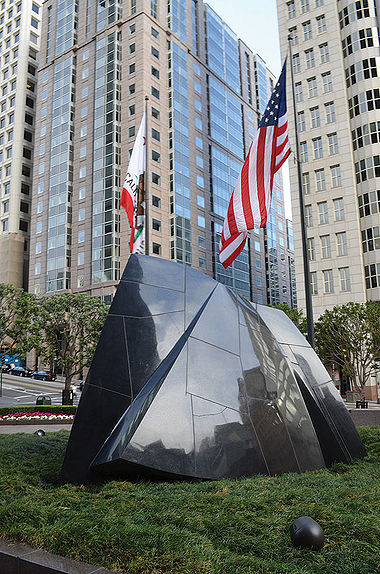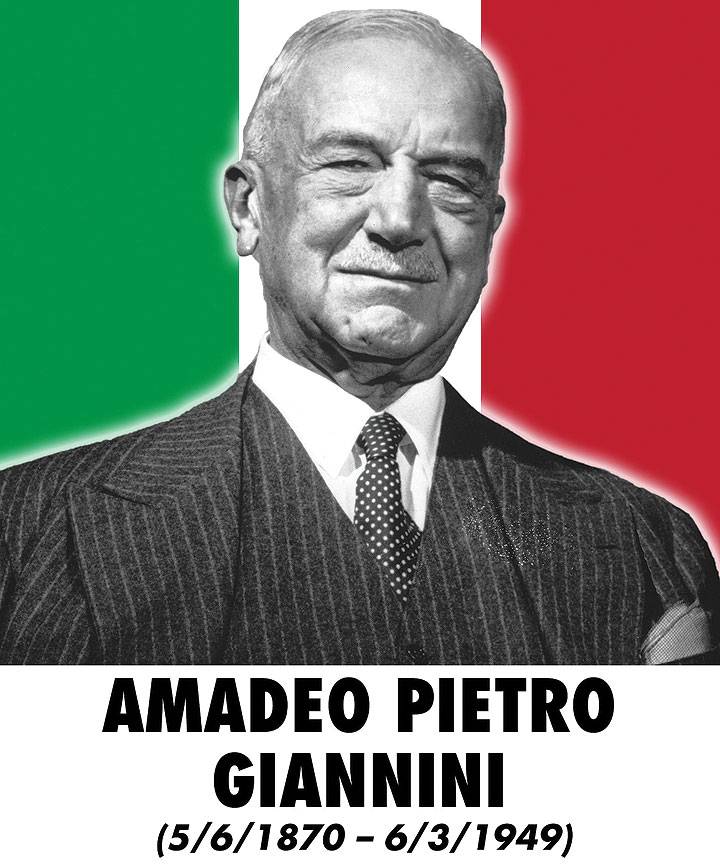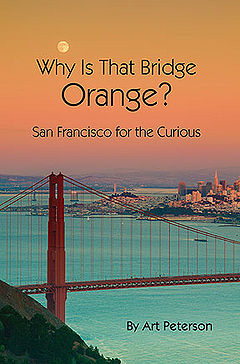A.P. Giannini: The Banker's Heart
Historical Essay
by Art Peterson
Transcendence at A. P. Giannini Plaza
The textbook name for this piece, located at the southeast corner of Kearny and California Streets, is Transcendence. Thanks to a rechristening by Chronicle columnist Herb Caen, the work soon took on another appellation: The Banker’s Heart.
The work, by the Japanese sculptor Masayuki Nagare, has been at the center of the A. P. Giannini Plaza since 1971, fronting the Bank of America Building, one-time headquarters of the institution that Giannini founded. Caen, of course, would have known that this labeling of this 200 tons of Swedish granite lacked even a metaphorical connection to the tough, but soft-hearted businessman.
Giannini was, in fact, the rare banker to challenge the notion that banks should only loan money to those who don’t need it. In his early years, dealing with farmers as the successful front man for his stepfather’s San Francisco produce business, Giannini soon discovered that the contempt bankers had for ordinary people was reciprocated. Leaving the family business at age 31, he got a close look at this mutual distrust when he went to work for Columbus Savings and Loan, a small North Beach bank that he found only wanted to do business with the established neighborhood merchants. So in 1904, he set up his own bank, the Bank of Italy, across the street from Columbus Savings. Right away, he set out to show that his bank would be different. He went door to door in North Beach explaining to residents that their money would be better off with him than being stored in jars and under mattresses.
Giannini’s big break came during an otherwise catastrophic time in 1906 when the city was devastated by earthquake and fire. Learning of the disaster in his San Mateo home, he left immediately for the city. Knowing that the fire was approaching, he packed up $80,000 from his vaults, borrowed a wagon from his stepfather’s produce business, loaded up the treasure, covered it with oranges and produce as disguise, and returned to his San Mateo home to stash his cache.
A few days later, setting up a stand in the heart of North Beach, on a plank supported by beer barrels, A.P. was back in business. He had two advantages over the competition. Other banks were unable to get into their piping-hot vaults because if they opened them the money inside would burst into flames. Further, the records of these banks had been destroyed. This was not a problem for A.P. He carried depositors’ records in his head. Giannini went on to create the modern bank as we know it. He was the first to open branches, make small loans, provide home mortgages, and facilitate installment credit. By 1924, his bank had more individual depositors than any other bank in the country. In 1928, the Bank of Italy became the Bank of America.
As a lender, A.P. was always ahead of the curve. He was the banker who first advanced auto loans. He funded the movie industry when other banks thought films were a passing fancy, and he purchased $6 million in bonds that jump-started the building of the Golden Gate Bridge.
In the 1920s, after Giannini opened his bank building headquarters at Powell and Market Streets, “the people’s banker” could be seen working on the bank’s floor with his colleagues. Giannini had drawn up a list of principles to give his bank direction, one of which stated, “The resources of the bank are not to be used for the enrichment of its officers.” When A. P. died in 1949, his worth was $500,000, having given many millions to worthy causes. Current-day Wall Street plutocrats, please note.
Excerpted with permission from Art Peterson's book, "Why Is That Bridge Orange?" published in 2013, by Inquiring Minds Productions.



